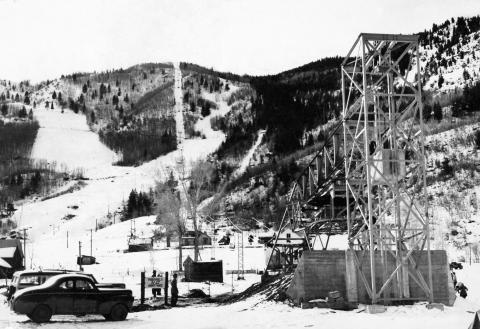
Meet the folks who built Aspen’s first chairlifts, 75 years ago.
Aspen Mountain celebrates its 75th anniversary of lift-served slopes this winter, but the area’s skiing history started well before that. In 1899, cut off from supplies by a fierce snowstorm, miners fashioned crude skis from the board walls of their homes and schussed down to Aspen. According to the Aspen Historical Society, the refugees dubbed their escape the first race of the “Hunter’s Pass Ski Club.”
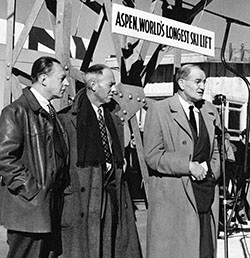
Aspen Mayor Albert Robison and
Colorado Governor Lee Knaus at the
official opening of Lift One, January 11,
1947. Aspen Historical Society (AHS)
Photo above: The lower mountain in 1947, shows Roch Run and Lift One. To the right of Roch Run is the cut path of the boat tow, which carried skiers through 1946 when Lift One was opened. Aspen Historical Society photo.
Most of the mines closed, but skiing survived. In 1936, several skiers, including Swiss mountaineer André Roch, planned a ski area at Mount Hayden, a few miles southwest of Aspen (see Skiing History, March-April 2021). Roch also plotted the first ski run on Aspen Mountain that year, and it was cut the following summer. Skiers could skin up or catch a ride up the backside on mining trucks. Starting in January 1938, the eight-seat “boat tow” ran 600 feet up the front. The boat was a pair of sleds, hauled by a cable along old mine hoists, powered by a Studebaker engine. Skiers built a warming hut and even a 55-meter ski jump.
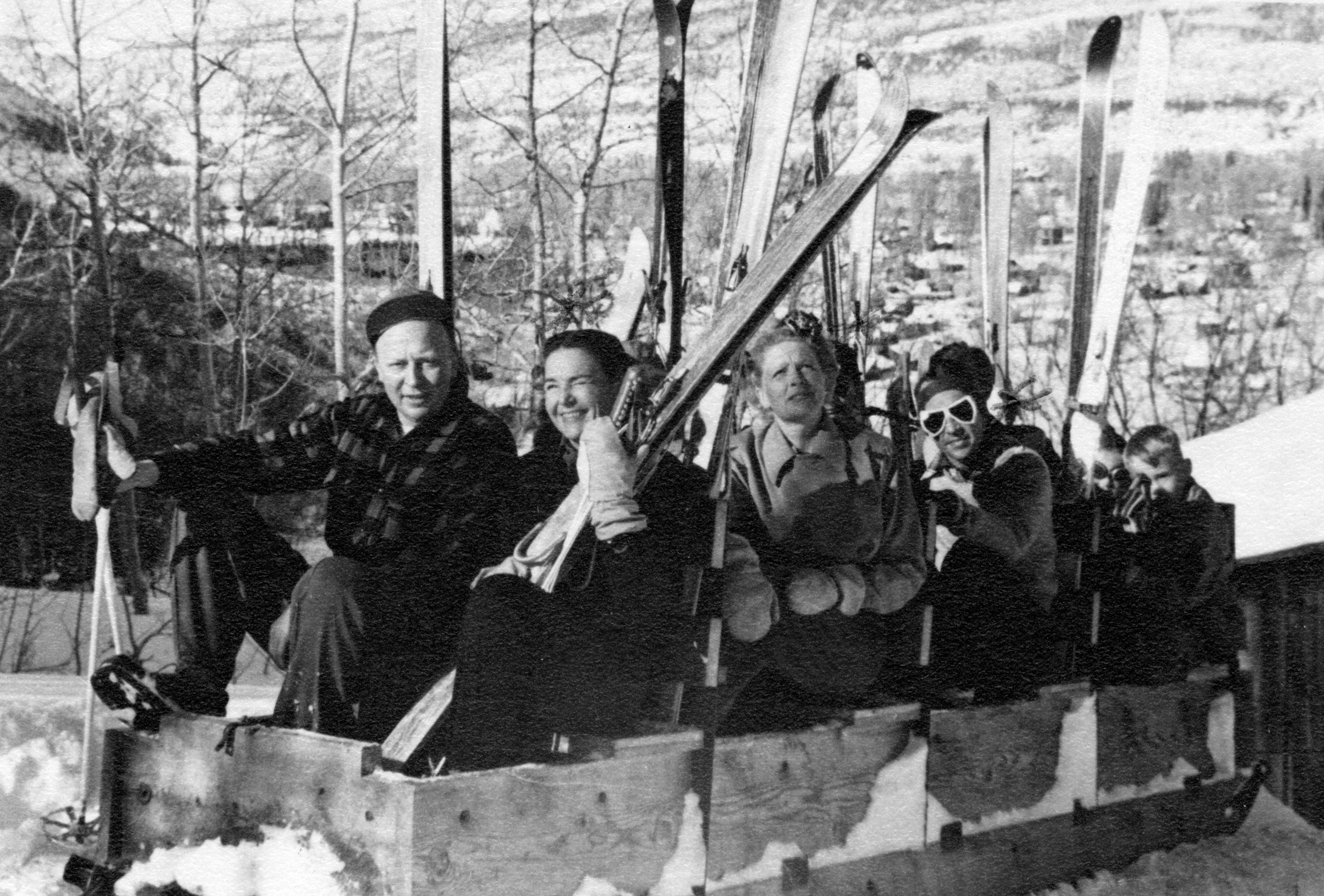
Lichtfield (front row), Meg Brown and Friedl
Pfeifer in the large sunglasses. The eight
passenger “boat” rose 600 feet in three
minutes. The tow ferried skiers through
1946, until the opening of Lift One in
January 1947. AHS/Litchfield Collection
“From a local perspective, Aspen was already known as a ski place,” says Tim Willoughby, a former schoolteacher who grew up in town and now contributes a weekly history column to the Aspen Times. He adds that ski clubs came from around the country to race, and the national downhill and slalom championships took place on Roch Run in 1941.
Pfeifer meets the Paepckes
Friedl Pfeifer, an Arlberg-Kandahar combined champion and wounded 10th Mountain Division vet, knew Aspen from his time teaching troops at Camp Hale. He envisioned a full-fledged ski resort on Aspen Mountain and returned there after getting out of the hospital in August 1945. By December, partnered with John Litchfield and Percy Rideout, he had a ski school operating, served by a new rope tow as well as the boat tow.
At the same time—the summer of 1945—outdoorswoman and skier Elizabeth Nitze Paepcke brought her husband, Chicago industrialist Walter Paepcke, to Aspen. Paepcke envisioned a cultural center capable of attracting artists, musicians and
intellectuals to a mountain retreat. He immediately invested more than $10,000 in bargain-priced downtown real estate. According to the Chicago Tribune (January 28, 2001), in order to assure the success of his investments and his cultural center, Paepcke threw in with Pfeifer’s ski-resort proposal.
Paepcke, Pfeifer, Litchfield and Rideout formed the Aspen Ski Corporation in 1946. Paepcke undertook to raise $300,000 for lift construction, mostly among Chicago investors. As
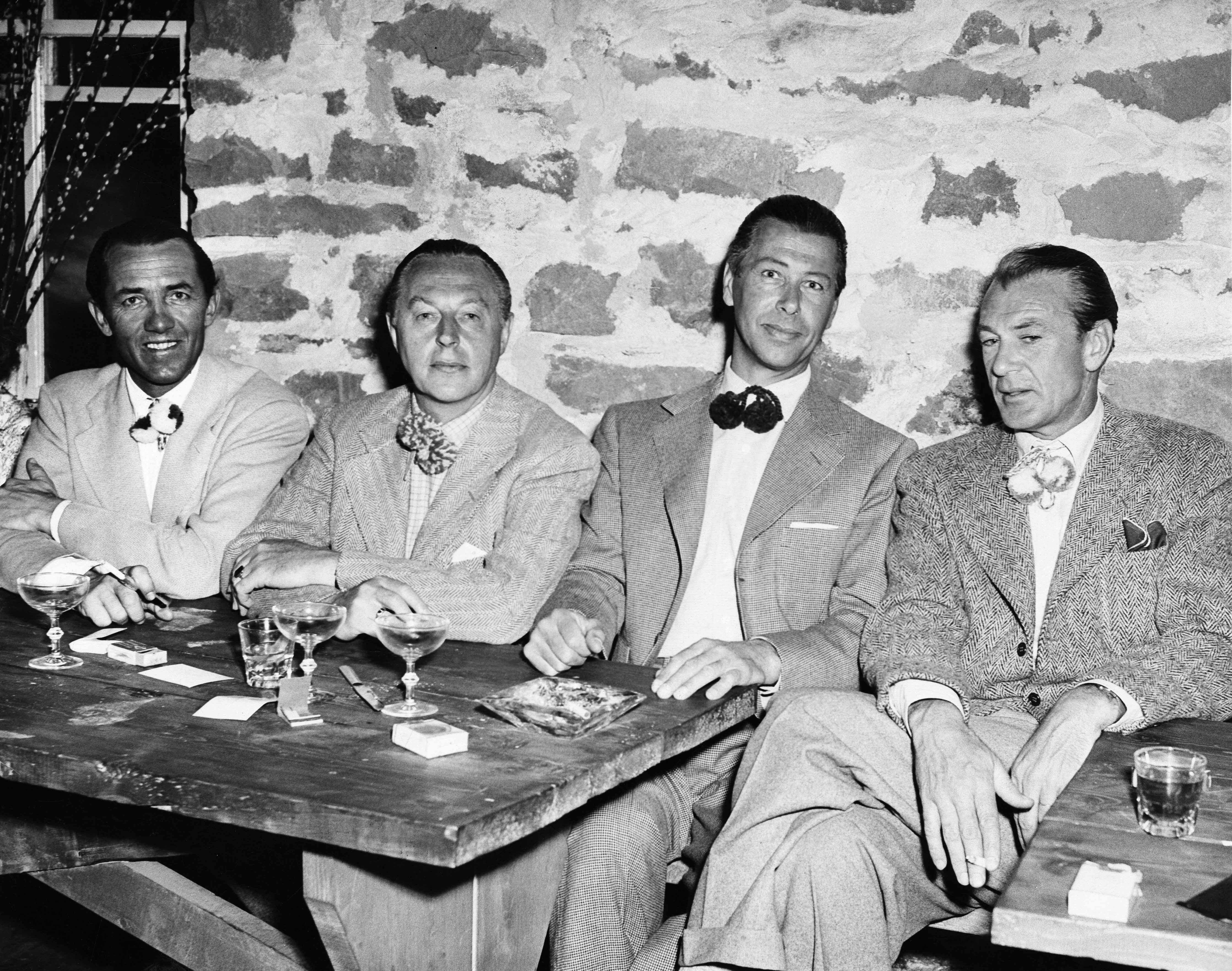
Cooper at the Four Seasons Club, circa
1955, all wearing the Koogie pom-pom
ties sold by Klaus Obermeyer.
AHS/Ted Ryan Collection
they planned the lifts, the new partners had to negotiate leases with the owners of mining claims scattered around the mountain. Denver attorney Bill Hodges was hired to help with the process, and became an investor. Many of the claims belonged to D.R.C. “Darcy” Brown Jr., who then invested in the Ski Corp., too.
Local crews pitch in
In summer 1946, construction began on two single-chair lifts that together would ferry skiers more than 3,000 vertical feet to the summit, opening a vast swath of terrain and creating one of the country’s premier ski destinations. A September 1946 article in the Aspen Daily Times reported that Lift 1 would be the world’s longest (at 8,400 feet in distance) and fastest chair (550 feet/minute), as well as the one with the most capacity (275 riders/hour) and largest vertical rise (2,400 feet). The lifts would serve more than 22 miles of ski trails.
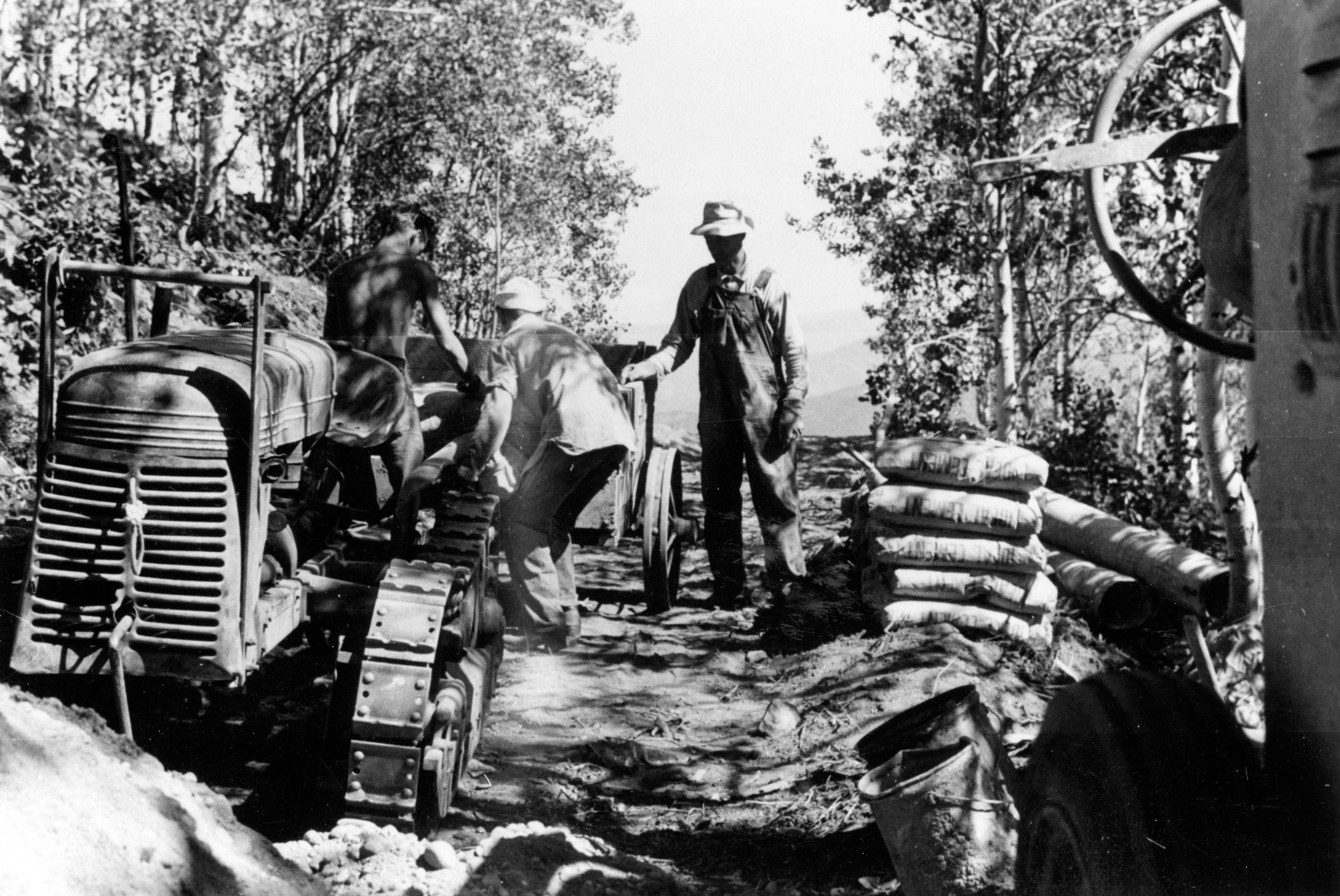
Lift One was manufactured by American
Steel and Wire, but installed by local
crews. AHS/Litchfield Collection
As lift lines were cleared and construction started, a trail crew headed by Litchfield and Rideout cut new runs and widened Roch Run. Wrote the Aspen Times in 1945, “Contrary to the popular belief that skiing on Aspen Mountain will be only for the above average, there will be many places on the upper slopes … that will satisfy and delight every class of ability.”
Delayed parts
The transformation into a ski hill overlapped the end of the mining era. Willoughby’s uncle, Frank, a mining engineer and president of the ski club, surveyed the lift lines. Willoughby’s father, Fred Jr., worked in the family’s Midnight Mine on the mountain’s backside, and helped oversee construction of Lifts 1 and 2. As Willoughby relates, the lift tower foundations had been prepped, but the towers themselves were delayed and didn’t arrive until late in October, when snow had already begun to fall.
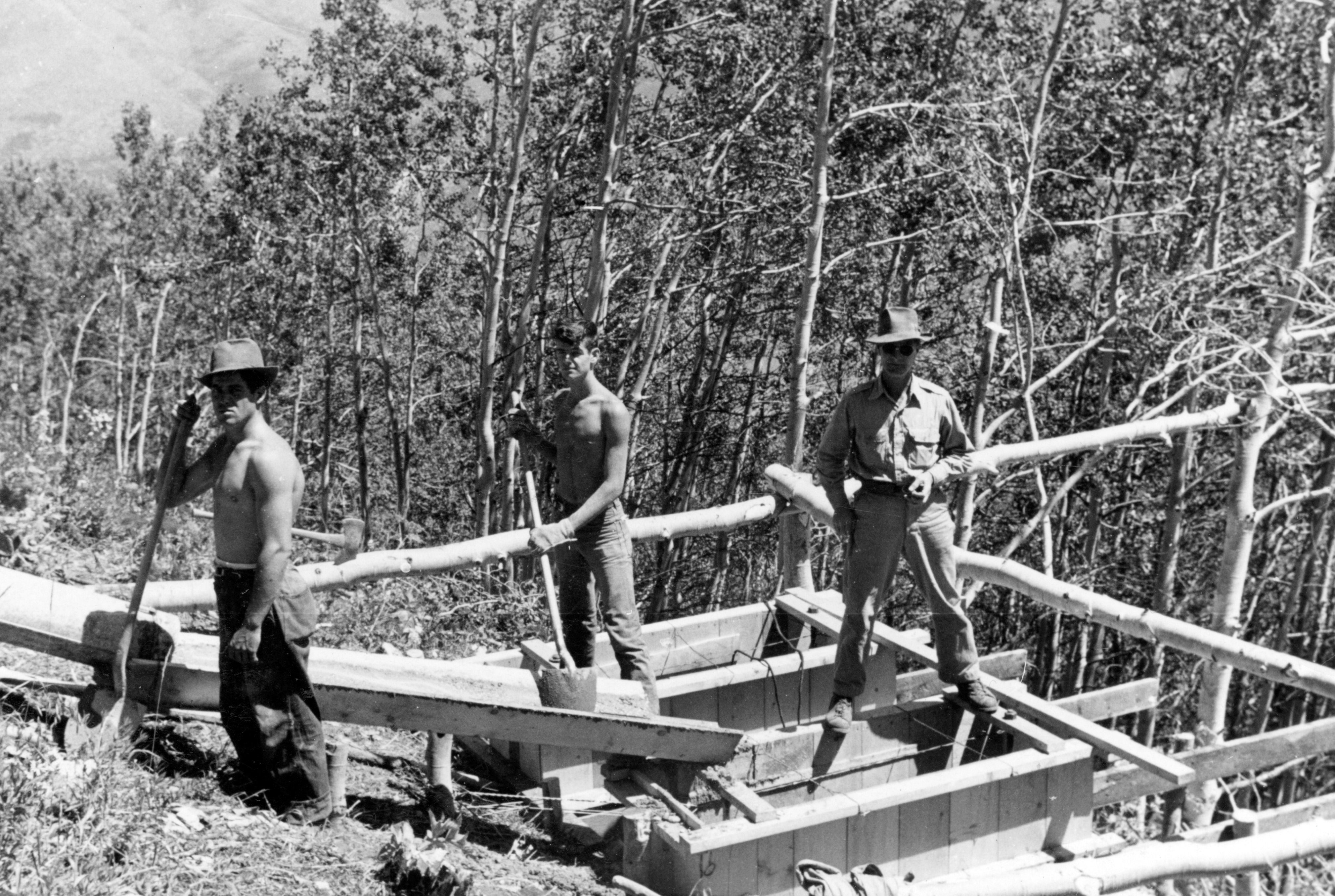
AHS/Litchfield Collection
Paul Purchard, a Swiss-born engineer then living in Denver, designed some of the Lift 1 components. His future son-in-law Harry Poschman, a 10th Mountain veteran, worked on the construction crew pushing to get the chairs in place for the winter. “He said it was miserable work,” said Harry's son Greg Poschman, today a Pitkin County Commissioner. “They got the last bullwheels on as the snow was flying.”
Then the Lift 1 electric motor didn’t show up (partially due to a post-war copper shortage), and a backup gasoline engine ran it the first winter. When Fred Willoughby became superintendent of lift operations, he had to go partway up the mountain every morning to fire up the engine (an electric motor could have been turned on from the base). Meanwhile, Lift 2 had a money-saving design that used recycled mining-tram parts. “The whole winter my father kept fixing that lift,” says Tim Willoughby. The next season, Fred Jr. was back with the family business. “He was a miner,” Willoughby adds. “Running the ski lifts wasn’t what he wanted to do.”
The mountaintop Sundeck, an innovative octagonal day lodge designed by prominent Bauhaus architect Herbert Bayer, was completed in November.
When Lift 1 debuted on December 14, 1946, rides were free for the day; afterward, a day pass cost $3.75 ($1.50 for locals), about $53 and $21 in today’s money. Lift 2 opened the following week. On January 11, 1947, the official grand opening took place, with Colorado’s Governor-elect William Lee Knaus, Senator Edwin Johnson, other dignitaries and a slew of media on hand.
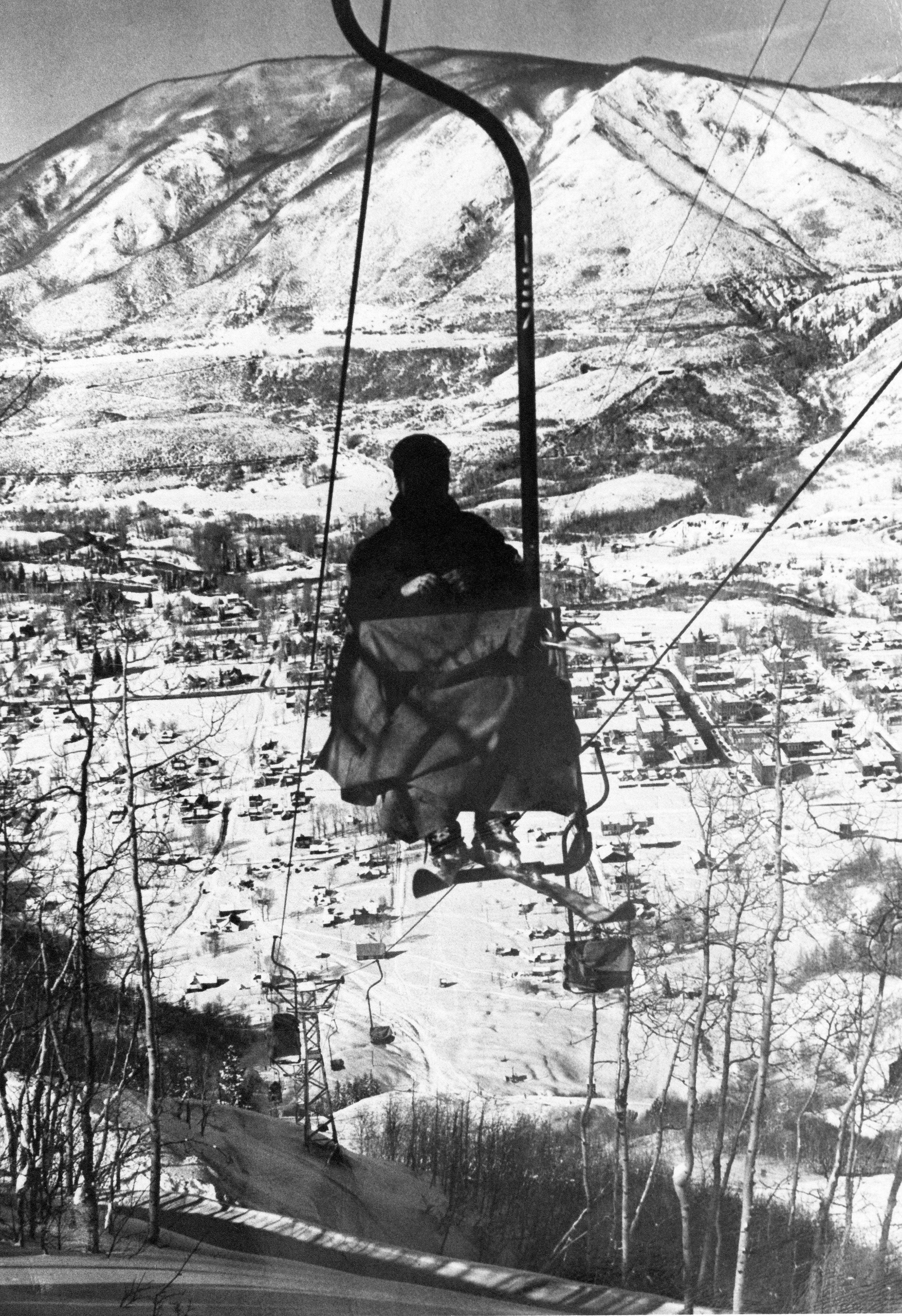
Lift One ride-time by knitting in 1948.
45-minute ride
A ride to the summit via the two chairs lasted 45 minutes. Skiers shivered with cold. A yellow, wool-lined canvas tarp covered the chair, with a poncho-style hole for the passenger’s head, recalls Marilyn Wilmerding, whose father, Bill Hodges, served as Ski Corp. president from 1951 to 1957. “We all wore raccoon coats that we found at the thrift shop,” she adds. Once off the lift, “you’d take off your fur coat, throw it on the chair, and it would go back down. There was a big, flat table at the bottom of the mountain with a pile of these fur coats. You’d rifle through them and find yours, then put it back on and get in line for the lift.”
The long, frigid lift rides inspired Klaus Obermeyer, who arrived in Aspen in late 1947, to design and sell his first down jackets.
By the second season of lift-served skiing, the new Little Nell run had been cleared at the base to accommodate beginners, served by a T-bar. Friedl Pfeifer had resigned as head of the Ski Corp., though he continued to lead the ski school, which was a separate entity. Aspen was on its way to becoming a celebrated ski destination. In 1950, thanks to the lobbying efforts of Frank Willoughby and Ski Corp. general manager Dick Durrance, the FIS World Alpine Championships came to Aspen, the first time the event was held outside of Europe.
Not everyone shared the enthusiasm. Even before the lifts opened, some locals worried that a sport catering to the rich would lead to inflated prices and an insurmountable class divide. “There is a possible danger in the current campaign to dust off and refurbish the mining camps of yesteryear,” wrote columnist Lee Casey in a 1946 Rocky Mountain News opinion piece titled “Worry About Aspen.” He warned of “Sun Valley prices” and an “invidious distinction” between wealthy tourists and locals.
Aspen attracted an eclectic mix of new residents drawn by the developing economic base, new cultural organizations like the Aspen Music Festival and the charm of a remote and scenic community. Recalls Poschman, “It was a place for refugees, heirs and heiresses thrown out of their families, gay people shunned by their East Coast families. The stories my parents would tell.” He adds, “There were former German soldiers who were skiers, next to 10th Mountain guys, all drinking beer together in the Red Onion.”
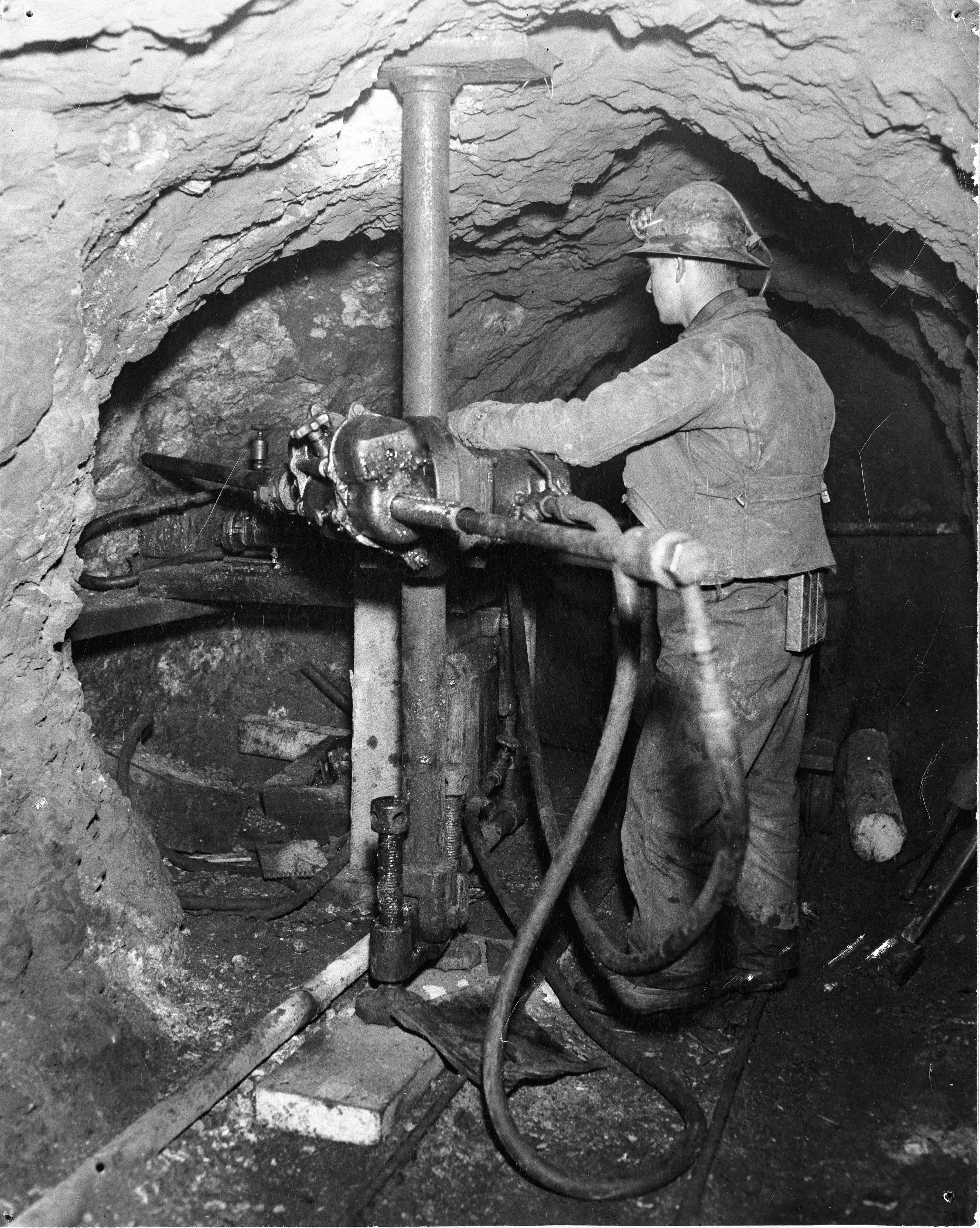
Midnight Mine, but took a break to boss a
construction crew and later became lift
supervisor. His brother Frank, president
of the ski club, surveyed the lift lines.
AHS.
Ski bum life
Poschman’s parents met as young ski bums in Alta and became engaged in the summer of 1946, when Harry was working on the Aspen lift-building crew. They moved to town full time in 1950 and ran the Edelweiss Inn out of an old Victorian on Main Street before building their own lodge, with Swiss-style chalets, later in the decade.
“We thought it was the most wonderful way to make a living in the world,” says Jony Larrowe (Greg Poschman’s mother). Larrowe skied for a few hours whenever she could get a babysitter, and Harry instructed in Pfeifer’s ski school, by that time co-directed by Fred Iselin. “Aspen became pretty famous, pretty fast,” says Larrowe. Most of the early Edelweiss guests came from Texas and elsewhere in Colorado and included college students, who paid just $2.75 a night if they brought a sleeping bag.
Larrowe’s own experience to the contrary, she says that skiing was still more of a man’s sport in the early 1950s and that lodge guests were “either single men or families who loved to ski and wanted their kids to learn how.”
Of course, Aspen kids didn’t have to wait for a family vacation to tackle the slopes. “The first time I skied Aspen Mountain was in 1949,” says rancher Tony Vagneur, whose great-grandparents settled in the area in the 1880s. “I was three years old.” Vagneur remembers struggling with too-long skis as he descended the Little Nell run. Too small to ride the T-bar, he needed someone else to pull him up the hill.
By first grade, Vagneur and friend Jimmie Johnson were skiing together every weekend, covering most of the mountain. “Every run was an adventure,” he says. “It probably still is for kids today.”
The elementary school released kids early on Wednesdays, and they could either ski on Aspen Mountain, ice skate or go to study hall. Vagneur, no surprise, opted to ski. When Vagneur was in fifth grade, his father worked on the mountain, running Lift 2 from its bottom station. Vagneur would sneak a ride up Lift 1 with his father in the early morning, then ski down and head to school—until the time mountain manager Red Rowland caught him doing it. “He was at Midway [at the top of Lift 1] when I got off the lift that morning, and he said, ‘What are you doing here?’” relates Vagneur. “He made me quit.”
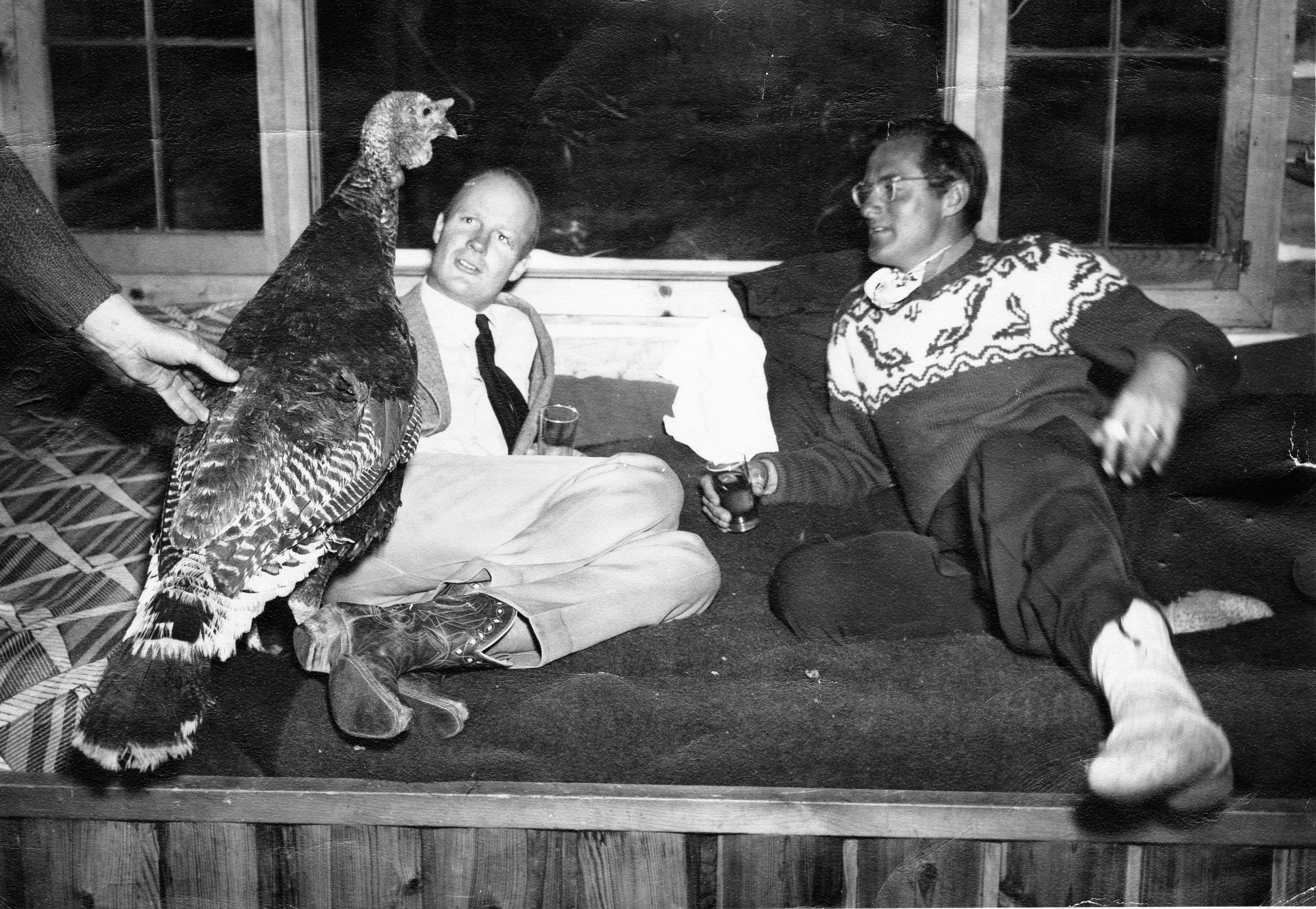
a friend in 1946. 10th Mountain vet
Litchfield was one of the original four
partners; Brown invested because he
owned some of the mining claims. AHS.
Vagneur spent seven years on ski patrol in the 1970s and today gives weekly history ski tours on behalf of the Aspen Historical Society. Despite the addition of lifts and a gondola, as well as more runs, “It still seems like the same place to me,” he says. “I start down the top of Copper and think, ‘Yeah, I’m home.’ It’s kind of like walking up the sidewalk to your house.”
Darcy Brown took over as president of the Ski Corp. in 1957, and his daughter Ruthie Brown grew up skiing Aspen Mountain. One of the resort’s best-known trails, Ruthie’s Run, is named after Darcy’s wife. As Brown tells it, her mother didn’t like skiing the standard route down the mountain. So she asked Red Rowland to cut a new trail for her. Ruthie’s Run opened to the public in December 1948. “It’s flowing and has great views of Aspen,” says Brown. “And my mother loved the sun. It gets the last sun of the day.”
Marilyn Wilmerding’s family came to Aspen on weekends and holidays, and during the summer, as her father fulfilled many of his Ski Corp. responsibilities from Denver. The Hodges first shared ownership of a Victorian with the Robinson and Coors families, then built an A-frame on Red Mountain, where Wilmerding lives today. As a young girl, she skied Aspen Mountain every chance she had. Angling for first chair each morning, she and her brother would arrive at the base of Lift 1 at 7 a.m. and line up their skis, then eat breakfast at the nearby Skier’s Chalet and board the lift when it opened at 9 a.m. “We would ski until the very end of the day,” she says.
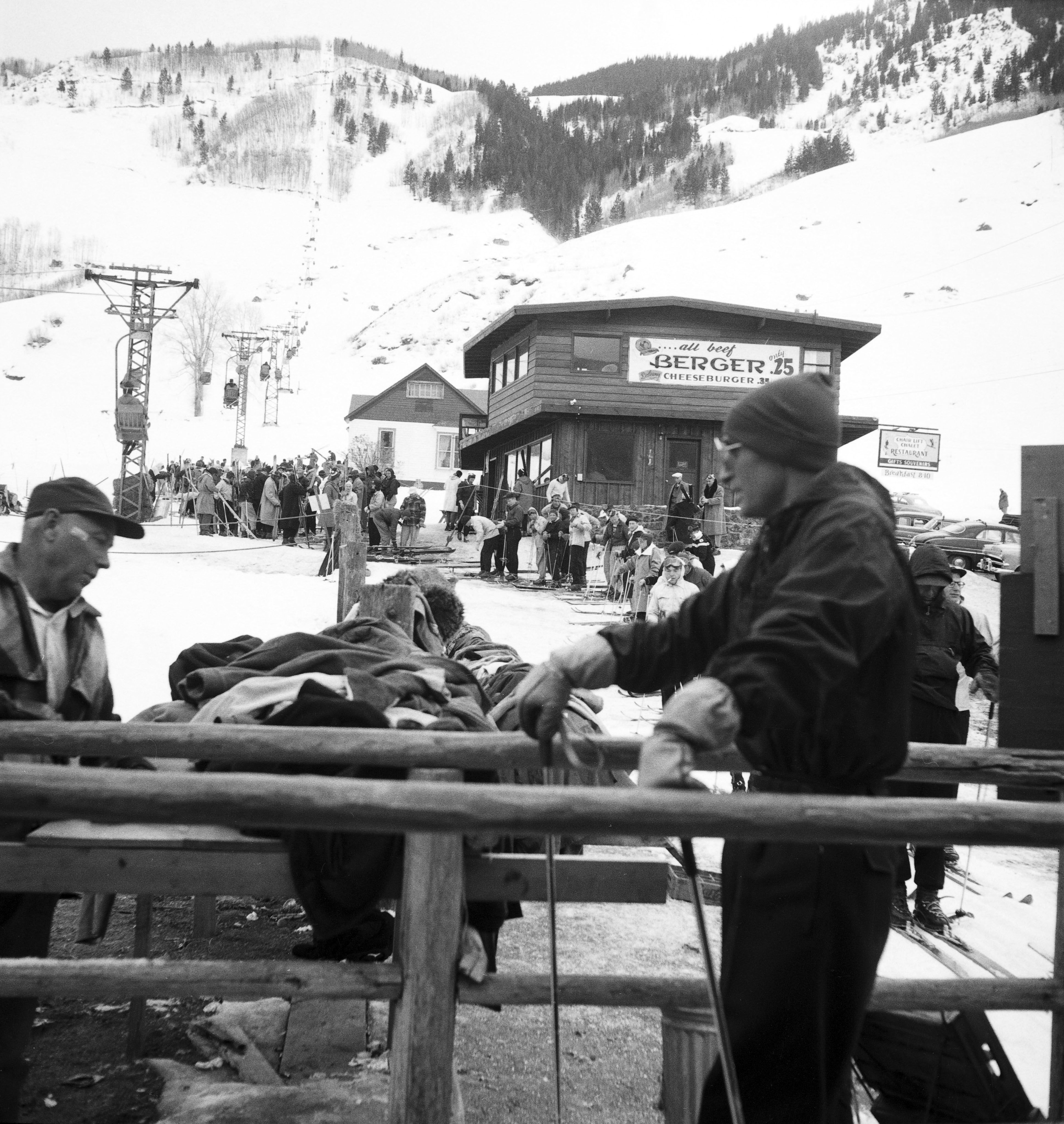
business for the “Berger” shack (25
cent Bergers). Riders collected their coats
from the loading station table with the help
of an attendant. AHS/Ringle Collection
After skiing, Wilmerding says, “Everyone would gather at the Hotel Jerome. Kids would run up one set of stairs in the lobby and down the other. It was like our own little club.” Dinners out were at the Red Onion, and the Isis Theatre showed the latest movies. She also remembers her parents going to lively parties at the “Pink House,” owned by the Browns. “It was a magical time to be here,” Wilmerding says. “Aspen has marked so many people, hasn’t it?”
Indeed, those heady early days of lift-served skiing launched Aspen on a trajectory that’s soared beyond what anyone may have imagined 75 years ago. And whether they were miners, ranchers, 10th Mountain veterans, ski visionaries or souls in search of a beautiful and free-wheeling place to live, residents during the first years of the new era were indelibly affected—perhaps none more so than the people who labored to create the new ski area.
Twenty-five years after the lifts opened on Aspen Mountain, in 1971, Lift 1A replaced Lift 1, starting farther uphill. Tim Willoughby relates seeing a photo in the Aspen Times of a helicopter removing the original lift towers. “I was with my father, who was living in California at that point,” he says. “He just looked at the photo: ‘I spent a whole year building that sucker, and in something like four hours they pulled it all out.’ It was one of his great achievements in life, and in a few hours, it was gone.” 
Author Cindy Hirschfeld is editor-in-chief of Cross Country Skier magazine. She spent six years as chief editor, successively, at Aspen Magazine and Aspen Sojourner.

